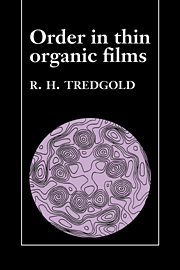Book contents
2 - Definitions of order and methods of its measurement
Published online by Cambridge University Press: 21 September 2009
Summary
Definitions of order
In the last chapter we have used the word ‘order’ without giving it any precise meaning. Most definitions of order involve thermodynamic concepts. Thus, for example, one might say that the most ordered state of a system is the one to which the system tends as the temperature tends to absolute zero. This definition would, however, be of little service in the present context. Most of the systems which we will discuss are remote from thermodynamic equilibrium. This is true both of the films during their preparation and also of the ‘final’ prepared films. However, these prepared films are in states of metastable equilibrium which are likely to survive for periods long compared with the time taken to carry out experiments on them and, very often, for periods so long as to be, from a human point of view, infinite.
We thus need a different definition of order. Here it is suggested that we view the most ordered state as the one which corresponds most closely to some preconceived structure which we wish to bring about. From a practical point of view the extent to which we can tolerate disorder may vary widely depending on the context. Thus, for example, in a system analogous to a chain of DNA encoding the structure of a particular enzyme, a single defect may render the system useless.
- Type
- Chapter
- Information
- Order in Thin Organic Films , pp. 14 - 38Publisher: Cambridge University PressPrint publication year: 1994



